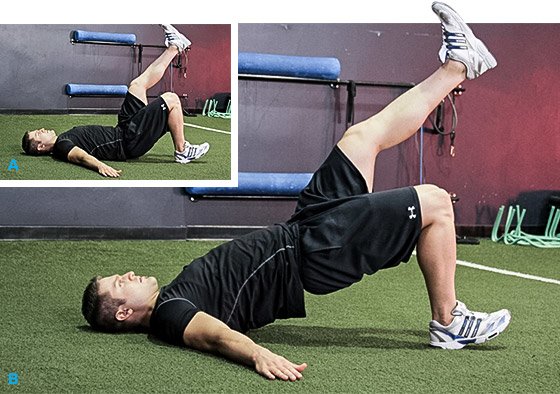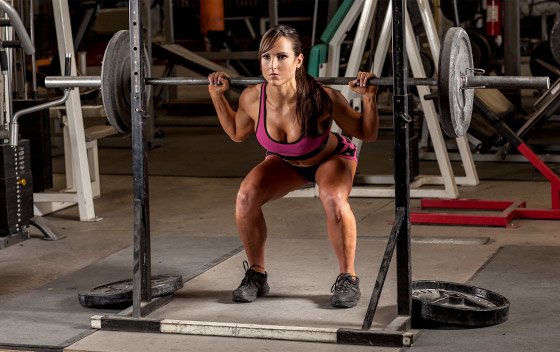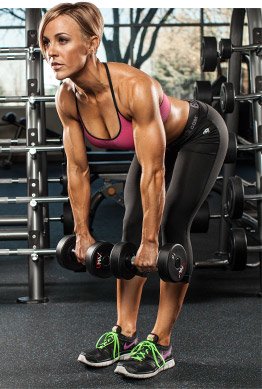Strong, round glutes are the foundation of a great physique and a healthy body. Unfortunately, many of us have weak glutes that just get weaker because we sit all day. Aside from not looking so great, feeble butt muscles can cause a litany of postural problems and pain issues. Even worse, having a weak bum means your primary lifts like the squat and the deadlift aren't as strong as they could be. If that doesn't motivate you to put some muscle on your backside, I don't know what will!
To restore your ailing glutes, you need to make training them a priority. Otherwise, you'll be stuck with constantly tight hips and probably contract flat-ass disease.
Save your butt from these depressing side effects by following these five rules. They'll help you feel stronger and more mobile. They'll also help you add some great-looking curves to your rear end.
Hit Them Baby One (Okay, Three) More Times
If your training routine only calls for one glute-specific workout per week, it's time to ramp things up. Glutes adapt well to frequency— the more often you train them, the quicker they grow in size and strength. Rather than performing a single glute workout once per week, add booty-busting exercises to each workout you do during the week.
Try this: Add loaded hip thrusts, glute bridges, hip abduction exercises, back extensions, or hip extension exercises to your daily workouts.

Single-leg bodyweight glute bridge
Mix Up Your Hip Extension
Hip extension is important for pelvic stability and daily movement. Walking, running, standing, and sitting in with proper posture begins and ends with your butt.
In this age of computers and cubicles, people spend most of their time in hip flexion (seated position). More often than not, long bouts of sitting cause tight quads, a tight psoas muscle, and weak hip extensors—namely the gluteus maximus.
To alleviate these symptoms and put yourself on a path to a perkier posterior, it's wise to activate your hip extensors regularly. Hip extension occurs when the thighs or pelvis move rearward. The most common—and best—exercises for hip extension are the squat and deadlift. These two lifts belong in your lifting regimen along with assistance exercises to pack on glute mass.
Try this: Use squats and deadlifts as a primary hip extension exercises and add in one or two assistance exercises to each routine. Assistance lifts include, but aren't limited to: the Romanian deadlift, single-leg Romanian deadlift, hip thrust, glute bridge, back extension, reverse hyperextension, glute kickback, and donkey kick.

Add a Little Abduction, Too
Your hips articulate in several ways other than the all-important extension. Your hips can also move in flexion, medial and lateral rotation, adduction, and abduction. If you move your hips in circles, you'll get the idea. Along with hip extension, another important element of strong glutes is hip abduction, or moving the thighs outward from your midline.
Your glute medius is a major abductor of the thigh. Its anterior fibers rotate the hip internally while the posterior fibers rotate the hip externally. A strong glute medius will control any unwanted sideways movement in your pelvis. For example, if your left hip drops when you stand on your right leg, your right glute medius is probably weak. An unlevel pelvis can lead to other issues like IT band syndrome and patellofemoral pain syndrome, neither of which is pleasant.
Try this: To strengthen the glute medius, add 2 sets of 10 reps of standing cable hip abduction and 2 sets of 12 reps of seated band hip abduction twice per week.
Keep Your Booty Active
If you sit on them all day, your glutes will just become weaker and weaker. This weakness can be compounded when other muscles have to take over a lift in order to compensate for them. Avoid a weak booty by doing a series of activation and mobility drills for at least 10 minutes a day. Practicing glute activation will help them fire during every exercise.
Try this: Perform 10 reps of each exercise once per day.
- Single-leg bodyweight glute bridge
- Fire hydrant
- Bird dog
- Standing glute squeeze
Get Tense

Mechanical tension is the bee's knees when it comes to muscle growth. Mechanical tension occurs when you passively stretch or actively contract the muscle. Passive tension is how your hamstring muscles feel at the bottom of a Romanian deadlift, and active tension is how your biceps feel as you contact in a barbell curl. Both are key players in muscle growth, and both can make a big difference in gluteal development.
When using a full range of motion (ROM), your muscles are placed under a combination of both passive and active tension. For example: At the bottom of a squat, your glutes are in a stretched (passive tension) position; at the top, they're in a squeezed (active tension) position.
Maintaining this tension through a full range of motion is optimal for gains. To do it, control your reps, keep a steady tempo, and don't rely on momentum to get through the exercise—oh, and don't skimp on the ROM.
Try this: To increase mechanical tension, use a tempo for your exercises. Tempo is expressed as a series of 3 or 4 numbers, such as 2-2-2. The first number is the number of seconds in the eccentric (lowering) portion of the movement, the second number is the pause, and the third number is the number of seconds in the concentric (lifting) portion of the movement.
You can incorporate an exercise tempo as simple as 2-2 or 3-3. You can also incorporate a pause in the middle, like 3-3-3, or even have a longer eccentric portion like a 4-3 tempo. Remember, though, that adding a tempo doesn't mean you get to forgo a full range of motion.

